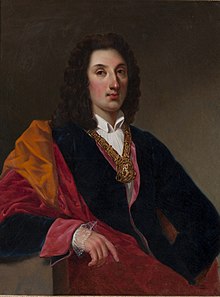Louis Thomas of Savoy-Carignan
Louis Thomas von Savoyen-Carignan , Count of Soissons (born August 1, 1657 in Paris , † August 24, 1702 near Landau in the Palatinate ) was an officer in the French and Imperial Roman-German army and the eldest brother of the general Prince Eugene of Savoy .
Life
Louis-Thomas was the eldest son of Eugen Moritz von Savoyen-Carignan , general and governor of Louis XIV, and Olympia Mancini , the niece of Cardinal Jules Mazarin . He grew up at the court of Louis XIV in Paris.
In 1674 the family thought about putting Louis Thomas up as a French candidate for the Polish throne.
After his father's unexpected death and their mother's exile because of their involvement in the Montespan affair , the children stayed with their grandmother, Marie de Bourbon-Condé, in Paris. Since the family had fallen out of favor with the king because of Olympia Mancini, Louis-Thomas inherited the title of Count of Soissons, but not, as usual, the offices and thus the father's income. The sisters remained unmarried, the sons Louis-Jules and Emanuel-Philibert pursued their military careers outside of France, as did the brother Prince Eugene of Savoy, who became one of the most famous generals in the service of the House of Habsburg .
In 1680 he married "improperly" Urania de la Cropte (1655-1717), the marriage resulted in six children, including Anna Victoria of Savoy , the chief heiress of Prince Eugen.

Driven into the enemy camp by Louis XIV , he unsuccessfully negotiated entry into the armies of Venice , the Netherlands , England and Spain . In 1699, the bankrupt Louis Thomas finally sought the help of his successful brother Eugen in Vienna and, through his mediation, joined the imperial army as Feldzeugmeister . At the beginning of the War of the Spanish Succession , he suffered serious injuries while conquering the French-occupied Landau fortress, to which he succumbed on August 24, 1702.
Individual evidence
- ^ Alfred Ritter von Arneth : Prince Eugene of Savoy. According to the handwritten sources in the imperial archives . 1. Volume 1663–1707, Vienna 1864, p. 7.
- ^ Alfred Ritter von Arneth: Prince Eugene of Savoy. According to the handwritten sources in the imperial archives . 1. Volume 1663–1707, Vienna 1864, pp. 7 and 126.
- ^ Alfred Ritter von Arneth: Prince Eugene of Savoy. According to the handwritten sources in the imperial archives . 1. Volume 1663-1707, Vienna 1864, pp. 125-126; and Max Braubach: History and Adventure. Shape around Prince Eugene . Verlag Bruckmann, Munich 1950, p. 97.
- ↑ Max Braubach: History and Adventure. Shape around Prince Eugene . Verlag Bruckmann, Munich 1950, p. 97; and Ernst Trost: Prinz Eugen . Verlag Amaltea, Vienna 1985, ISBN 3-85002-207-2 , p. 99.
literature
- Max Braubach : Prince Eugene of Savoy. A biography. Volume 1: Ascent. Oldenbourg, Munich 1963.
- Karl Gutkas (Ed.): Prince Eugene and Baroque Austria. Verlag Residenz, Salzburg et al. 1985, ISBN 3-7017-0428-7 .
| predecessor | Office | successor |
|---|---|---|
| Eugen Moritz |
Count of Soissons 1673–1702 |
Thomas Emmanuel |
| personal data | |
|---|---|
| SURNAME | Savoy Carignan, Louis Thomas of |
| ALTERNATIVE NAMES | Earl of Soissons, Louis Thomas; Savoy Carignan, Ludwig Thomas; Savoia-Soissons, Luigi Tommaso |
| BRIEF DESCRIPTION | Count of Soissons and brother of Prince Eugene of Savoy |
| DATE OF BIRTH | August 1, 1657 |
| PLACE OF BIRTH | Paris |
| DATE OF DEATH | August 24, 1702 |
| Place of death | Landau in the Palatinate |
